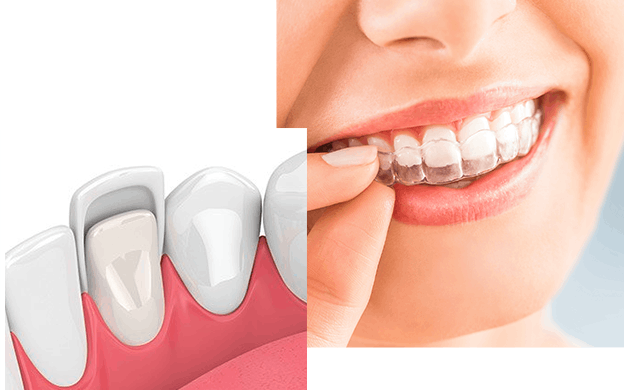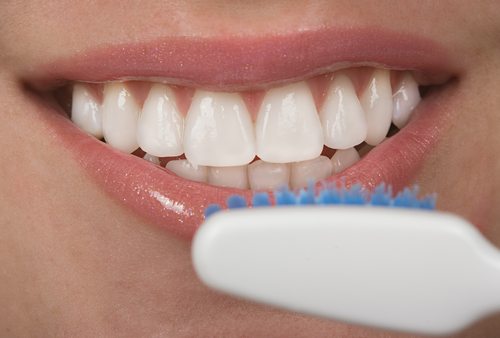A smile can be the most eye-catching feature of a face, and having teeth you’re confident with can make all the difference. With advancements in modern dentistry, achieving your dream smile is no longer a far-fetched dream. Composite veneers have gained popularity among the numerous options available due to their affordability and efficiency.
This guide will walk you through everything you need to know about composite veneers, demystifying the process and helping you make an informed decision. So, read on and let us light the way to a brighter smile!
What Are Dental Veneers?
Dental veneers, simply known as ‘veneers’, are thin shells made from either composite resin or porcelain that cover the front surface of your teeth. They are custom-made to match the color, shape, and size of your teeth, offering a natural and appealing look. Veneers are primarily used to enhance the smile’s aesthetic appeal by addressing various dental issues such as stained teeth, gaps between teeth, and misshapen or chipped and broken teeth.
Once applied, veneers fundamentally transform your smile, providing a lasting solution that is both functional and visually pleasing.
What Are Composite Veneers?
Composite veneers, also known as direct veneers, are a type of dental veneer that are applied directly onto your teeth by a dental professional. They are made from a highly malleable, tooth-colored resin which is sculpted on the tooth surface and then hardened using a special light. This process can typically be completed in a single dental visit.
The flexibility of the composite material allows for a highly customizable aesthetic result, enabling the creation of a natural-looking and radiant smile. Composite veneers are a popular choice due to their relative affordability and the speed of the treatment compared to other options like porcelain veneers.
According to Dental House Liverpool, composite veneers have an average lifespan of 5 to 7 years. (1) However, it’s important to note that the durability of veneers can vary based on individual habits and the amount of composite material used during the procedure. Proper oral hygiene practices and regular dental check-ups can help ensure the longevity of your composite veneers, allowing you to enjoy a beautiful smile for years to come.
Types of Composite Veneers
When it comes to composite veneers, there are primarily two types available – Direct and Indirect. They vary in the application process, cost, time, and durability. Understanding the differences between these types can help you make a more informed decision about which is right for you.
Direct Composite Veneers
Direct composite veneers are created chairside by your dentist. The dentist applies the tooth-colored resin directly to your teeth and sculpts it to the desired shape. The procedure is often completed in one visit, making it a convenient choice for those with busy schedules.


Indirect Composite Veneers
Indirect composite veneers, on the other hand, are fabricated in a dental lab based on the mold of your teeth taken by your dentist. Once crafted, they are then bonded to your teeth in a subsequent appointment. Indirect veneers tend to be more durable and offer a superior finish compared to direct veneers, but they also come with a higher price tag and require more than one dental visit.
Who’s a Candidate for a Composite Veneer Installation?
Composite veneers can be an effective solution for a wide range of cosmetic dental concerns, including chipped, discolored, or misshapen teeth. They are also a popular choice for those looking to close gaps between their teeth or improve the appearance of slightly crooked teeth.
However, not everyone is a suitable candidate for composite veneers. Your dentist will evaluate your teeth and oral health to determine if you are a good candidate for the procedure. Here are some certain conditions that may make you ineligible for a composite veneer installation:
- Poor oral hygiene
- Active gum disease or tooth decay
- Severe misalignment or crowding of teeth
- Bruxism (teeth grinding)
If you have any of these conditions, your dentist may recommend other dental procedures to address them before considering composite veneers.
Pros and Cons of Composite Veneers
Like any dental procedure, composite veneers come with their own set of advantages and disadvantages, which can greatly influence your decision.
Advantages of Composite Veneers
- Cost-effective: Composite veneers are typically more affordable than porcelain veneers, making them a popular choice for those on a budget.
- Non-invasive procedure: Unlike porcelain veneers, composite veneers do not require any removal of your natural tooth structure, making it a non-invasive option.
- Quick and easy process: The entire process of getting composite veneers can be completed in just one visit to your dentist, saving you time and hassle.


- Customizable: Composite veneers are made on the spot by your dentist, allowing for a more customizable experience to achieve the desired shape and color for your smile.
- Natural-looking results: When done correctly by an experienced cosmetic dentist, composite veneers can provide natural-looking results that blend seamlessly with your existing teeth.
Disadvantages of Composite Veneers
- Not as durable as porcelain veneers: Unlike porcelain veneers, composite veneers are not as strong and may need to be replaced more frequently.
- Susceptible to staining: Composite material is more likely to stain compared to porcelain, so it is important to avoid consuming staining foods and beverages.


- Not suitable for major cosmetic changes: While composite veneers can improve the appearance of minor imperfections, they may not be able to correct major flaws or misalignment.
- Requires maintenance: Composite veneers may require periodic touch-ups and replacements, adding to the overall cost.
Cost of Composite Veneers
The cost of composite veneers can significantly vary depending on several factors, such as the complexity of your case, the expertise of the dentist, and the geographical location. According to Healthline, around the country, the price could range from $250 to $1,500 per tooth. (2) Direct composite veneers tend to be more affordable than indirect composite veneers due to a simpler process and less time required. However, it’s important to remember that while cost is a significant factor, it should not be the sole determinant in your decision.
It’s essential to discuss with your dentist to understand what is included in the price and ensure that you understand what makes up the costs. Remember, investing in your smile is an investment in your confidence and overall quality of life.
Procedures for Fitting Composite Veneers
The process of fitting composite veneers typically involves several stages. Initially, your dentist will conduct a comprehensive dental evaluation. This is to assess the condition of your teeth and ascertain whether composite veneers are the best cosmetic solution for your particular situation.
Following this assessment, the dentist will prepare your teeth for the veneers. As composite veneers are minimally invasive, this often requires little to no enamel removal.
The next stage involves the application of the composite resin material. The dentist will carefully apply the resin to your teeth, skillfully sculpting it to achieve a natural and aesthetically pleasing shape. This process takes a keen eye and a steady hand, underlining the importance of selecting a well-experienced professional for the procedure.
Once the composite veneer is in place and looks satisfactory, the dentist will harden the material using a special light. This effectively bonds the veneer to your tooth, providing a secure and durable finish.
Lastly, your dentist will polish the veneer, giving it a smooth and shiny appearance that closely mimics the look of natural teeth. This final step is crucial for ensuring your composite veneers blend seamlessly with the rest of your teeth, providing a beautiful and confident smile.
Recovery and Post Veneer Care
One of the most significant advantages of composite veneers is that they require minimal recovery time. You can return to your normal activities immediately after the procedure, and any discomfort or sensitivity should subside within a few days.
To maintain the longevity and appearance of your composite veneers, it’s essential to practice good oral hygiene habits. This includes brushing twice a day, flossing daily, and visiting your dentist for regular check-ups. Avoid biting or chewing on hard objects, as this can damage the veneers. If you have a habit of clenching or grinding your teeth, your dentist may recommend wearing a nightguard to protect the veneers while you sleep.

Removal of Composite Veneers

The removal of composite veneers is usually a straightforward process that can be performed by your dentist. Due to the thinness of the veneers, they can typically be removed without causing significant harm to the underlying tooth structure. It’s important to remember, however, that this procedure should be conducted by a professional dental practitioner to ensure safe and correct removal.
Remember, the health of your natural teeth is always paramount, and avoiding unnecessary damage during veneer removal is critical. This is why having a trusted dental professional oversee your veneer removal is essential.
Composite vs. Porcelain: Differences, Similarities (Which is better?)
When comparing Composite and Porcelain Veneers, there are several differences and similarities to consider.
Composite Veneers are made from a resin material that can be directly applied and sculpted on the teeth. They are less expensive and can be completed in one visit. However, they are not as durable as porcelain and can stain over time.
On the other hand, Porcelain Veneers are crafted from a high-quality ceramic material, giving them a more natural appearance. They are resistant to staining and have a longer lifespan than composite veneers, yet they are more expensive and require at least two visits to the dental office.
Both composite and porcelain veneers can effectively enhance the aesthetics of your smile, addressing issues like staining, chipping, or misalignment. However, the choice between the two often boils down to the individual’s budget, aesthetic preferences, and lifestyle. It’s always best to consult with a dental professional when deciding which option is better for your personal needs.
Frequently Asked Questions
How long do composite veneers last for?
Composite veneers can last anywhere from 5-10 years with proper care and maintenance. However, this can vary depending on individual factors such as oral hygiene habits, diet, and any underlying dental issues.
Is composite veneer good for teeth?
Yes, composite veneers are considered a safe and minimally invasive option for improving the appearance of teeth. They require little to no enamel removal and can effectively address common aesthetic concerns such as discoloration or chips.
Is it hard to eat with composite veneers?
No, it should not be hard to eat with composite veneers. However, as with any dental procedure, there may be an adjustment period where you may feel slight discomfort or sensitivity while eating. This should subside within a few days.
What happens to composite veneers after 5 years?
After 5 years, the composite veneers may start to show signs of wear and tear. Depending on the individual’s oral hygiene habits and lifestyle, they may require replacement or touch-ups to maintain their appearance.
Can you go back to normal teeth after composite veneers?
Yes, it is possible to go back to normal teeth after composite veneers. Unlike traditional veneers, composite veneers do not require the removal of enamel, making them a reversible option. However, removing the veneers may result in some changes to the tooth’s appearance due to slight reshaping during the initial application process.
Can I remove composite veneers?
Yes, composite veneers can be removed if desired. However, it is recommended to consult with a dental professional before making any decisions. They will be able to assess the current state of the veneers and provide guidance on potential outcomes.
What is the best age to get veneers?
There is no specific age requirement for getting veneers, as it ultimately depends on the individual’s oral health and personal preferences. It is important to consult with a trusted dental professional to determine if veneers are the right option for you at any age.
How many times can you get composite veneers?
Composite veneers can be replaced as many times as needed, provided that the health of the underlying tooth structure is not compromised. However, it’s essential to practice good oral hygiene and visit the dentist regularly to extend the lifespan of your veneers.
Final Thoughts
Composite veneers are a versatile and effective solution for those looking to enhance their smile. They offer a more affordable alternative to porcelain veneers, with the added convenience of requiring just a single dental visit for application. While they may not have the same longevity or stain resistance as porcelain veneers, their easy maintenance and reversibility make them an attractive choice for many.
Here at Pinnacle Dental Group, we are committed to providing top-quality dental care and helping our patients achieve their dream smiles. If you are considering composite veneers, don’t hesitate to schedule a consultation with one of our experienced dentists. We will work with you to determine the best treatment plan for your individual needs and guide you through the process every step of the way.
Remember, a beautiful smile is just a dental visit away! So take care of your teeth and remember always to keep smiling.
References:
- American Cosmetic Dentistry
- Healthline
- Dental House Liverpool
